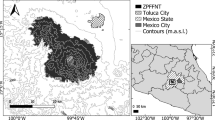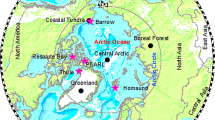Abstract
The Arctic air mass is a unique meteorological feature of the northern hemispheric atmosphere. Possessing well-defined meteorological characteristics, it occupies not only the polar region but also a large fraction of the Canadian and Eurasian land masses during the period November to April. Poor pollutant removal by precipitation and dry deposition within the air mass and a strong transport pathway between Eurasian mid-latitudinal sources and the north, result in elevated levels of acidic anthropogenic aerosols and gases in the air mass during winter. In summer, weak north/south transport and strong pollutant removal between the Arctic and mid-latitudes and within the Arctic, results in lower airborne concentrations of acidic pollutants. Due to the presence of the relatively polluted Arctic air mass, ‘background’ air concentrations of SO4 =, SO2 and total NO3 − are elevated in western Canada during winter. Typical mean monthly concentrations from December to March are 0.8 to 2.1, 1.0 to 2.4 and 0.1 − 0.6 μg m−3, respectively. In the absence of the neutralizing influence of alkaline soil dust, the acidity of snow forming in western Canada during winter is expected to range from 5 to 20 μeq l −1.
Similar content being viewed by others
References
Barrie, L.A.: 1986, Atmospheric Environment, 13, in press.
Barrie, L.A. and Hoff, R.M.: 1985, Atmospheric Environment, 12, 1995.
Barrie, L.A., Fishers, D. and Koerner, R.M.: 1985, Atmospheric Environment, 12, 205.
Barrie, L.A., Anlauf, K., Wiebe, H.A. and Fellin, P.: 1984, Acidic pollutants in air and precipitation at selected rural locations in Canada, in Deposition Both Wet and Dry, Ed. B.B. Hicks, Acid Precipitation Series, Vol. 4, Series Ed. J.I. Teasley, 15–35, Butterworths.
Barrie, L.A. and Hoff, R.M.: 1984, Atmospheric Environment, 18, 2711.
Barrie, L.A., Hoff, R.M. and Daggupaty, S.M.: 1981, Atmospheric Environment, 15, 1407.
Barrie, L.A., Wiebe, H.A., Anlauf, K. and Fellin, P.: 1980, Studies in Environmental Science, 8, 355.
Barrie, L.A.: 1980, The fate of particulate emissions from an isolated power plant in the Oil Sands area of western Canada, Ann. N.Y. Acad. Sci., Aerosols: Anthropogenic and Natural Sources and Transport, 338, 434–452.
Rahn, K.A.: 1971, Sources of trace elements in aerosols — an approach to clean air, Ph.D. thesis, Univ. of michigan, Ann Arbor, Michigan, Xerox Univ. Microfilms (order No. 72-4956), 325 pp.
Shewchuk, S.R.: 1986, Acid deposition sensitivities within the Northwest Territories and current deposition to the snowpack and small lakes chemistry of a selected area of the Mackenzie District, Proc. Int. Conf. on Arctic Water Pollution Research: Applications of Science and Technology. Water, Science and Technology in press).
Author information
Authors and Affiliations
Rights and permissions
About this article
Cite this article
Barrie, L.A. Background pollution in the Arctic air mass and its relevance to North American acid rain studies. Water Air Soil Pollut 30, 765–777 (1986). https://doi.org/10.1007/BF00303343
Issue Date:
DOI: https://doi.org/10.1007/BF00303343




